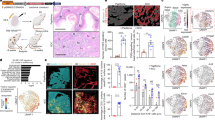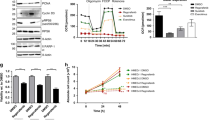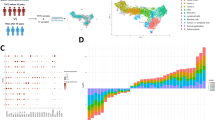Abstract
Recent studies demonstrate that the receptor tyrosine kinase (TK) Ron is tumorigenic when overexpressed and plays a role in regulating skin homeostasis. We hypothesized that Ron signaling promotes skin carcinogenesis. To test this hypothesis, mice deficient in the TK domain of Ron (TK−/− mice) were crossed with v-Ha-ras (Tg.AC) transgenic mice; the resulting TK−/− Tg.AC+/− mice, and their controls, were utilized in a model of chemically induced Ras-mediated skin carcinogenesis. The mice were treated with 2.5 μg of 12-O-tetradecanoylphorbol-13-acetate applied weekly to the shaved back of 36 control (TK+/+ Tg.AC+/−) and 35 experimental (TK−/− Tg.AC+/−) mice. In an analysis of the resulting papillomas, a reduction in cellular proliferation and papilloma volume was found in the TK−/− Tg.AC+/− mice compared to controls. Further, Ron protein expression was upregulated during papilloma formation. Ablation of Ron signaling resulted in partial defects in MAPK and Akt signaling that may account for the decreased papilloma growth in the TK−/− Tg.AC+/− mice. The papilloma-bearing mice were monitored for the occurrence of malignant skin tumors and other malignant tumor types for a period of 48 weeks. Loss of Ron receptor signaling significantly reduced the percent of papillomas that underwent malignant conversion as well as the number of mice developing other malignant tumor types. In conclusion, these studies demonstrate that Ron signaling augments papilloma growth and malignant conversion in vivo.
This is a preview of subscription content, access via your institution
Access options
Subscribe to this journal
Receive 50 print issues and online access
$259.00 per year
only $5.18 per issue
Buy this article
- Purchase on SpringerLink
- Instant access to full article PDF
Prices may be subject to local taxes which are calculated during checkout





Similar content being viewed by others
Abbreviations
- HGFL:
-
hepatocyte growth factor-like protein
- HGF:
-
hepatocyte growth factor
- TK:
-
tyrosine kinase
References
Agazie Y, Ischenko I and Hayman M . (2002). Oncogene, 21, 697–707.
Bohle RM, Brettreich S, Repp R, Borkhardt A, Kosmehl H and Altmannsberger HM . (1996). Am. J. Pathol., 148, 731–738.
Cardiff RD, Leder A, Kuo A, Pattengale PK and Leder P . (1993). Am. J. Pathol., 142, 1199–1207.
Chen Q, Seol DW, Carr B and Zarnegar R . (1997). Hepatology, 26, 59–66.
Collesi C, Santoro MM, Gaudino G and Comoglio PM . (1996). Mol. Cell. Biol., 16, 5518–5526.
Finkelstein LD, Ney PA, Liu QP, Paulson RF and Correll PH . (2002). Oncogene, 21, 3562–3570.
Franke TF, Kaplan DR and Cantley LC . (1997). Cell, 88, 435–437.
Furge KA, Kiewlich D, Le P, Vo MN, Faure M, Howlett AR, Lipson KE, Woude GF and Webb CP . (2001). Proc. Natl. Acad. Sci. USA, 98, 10722–10727.
Hennings H, Shores R, Balaschak M and Yuspa SH . (1990). Cancer Res., 50, 653–657.
Hennings H, Shores R, Mitchell P, Spangler EF and Yuspa SH . (1985). Carcinogenesis, 6, 1607–1610.
Ivan M, Bond JA, Prat M, Comoglio PM and Wynford-Thomas D . (1997). Oncogene, 14, 2417–2423.
Iwama A, Yamaguchi N and Suda T . (1996). EMBO J., 15, 5866–5875.
Kulesz-Martin MF, Blumenson LE, Manly KF, Siracky J and East CJ . (1991). Cancer Res., 51, 4701–4706.
Leder A, Kuo A, Cardiff RD, Sinn E and Leder P . (1990). Proc. Natl. Acad. Sci. USA, 87, 9178–9182.
Leonis MA, Toney-Earley K, Degen SJ and Waltz SE . (2002). Hepatology, 36, 1053–1060.
Maggiora P, Marchio S, Stella MC, Giai M, Belfiore A, De Bortoli M, Di Renzo MF, Costantino A, Sismondi P and Comoglio PM . (1998). Oncogene, 16, 2927–2933.
McDowell SA, Mallakin A, Bachurski CJ, Toney-Earley K, Prows DR, Bruno T, Kaestner KH, Witte DP, Melin-Aldana H, Degen S, JF, Leikauf GD and Waltz SE . (2002). Am. J. Respir. Cell. Mol. Biol., 26, 99–104.
Moore RJ, Owens DM, Stamp G, Arnott C, Burke F, East N, Holdsworth H, Turner L, Rollins B, Pasparakis M, Kollias G and Balkwill F . (1999). Nat. Med., 5, 828–831.
Nanney LB, Skeel A, Luan J, Polis S, Richmond A, Wang MH and Leonard EJ . (1998). J. Invest. Dermatol., 111, 573–581.
Okino T, Egami H, Ohmachi H, Takai E, Tamori Y, Nakagawa K, Nakano S, Akagi J, Sakamoto O, Suda T and Ogawa M . (1999). Int. J. Oncol., 15, 709–714.
Peace BE, Hughes MJ, Degen SJ and Waltz SE . (2001). Oncogene, 20, 6142–6151.
Pierceall WE, Goldberg LH, Tainsky MA, Mukhopadhyay T and Ananthaswamy HN . (1991). Mol. Carcinogen., 4, 196–202.
Rodriguez-Viciana P, Warne PH, Dhand R, Vanhaesebroeck B, Gout I, Fry MJ, Waterfield MD and Downward J . (1994). Nature, 370, 527–532.
Sakamoto A, Oda Y, Itakura E, Oshiro Y, Tamiya S, Honda Y, Ishihara A, Iwamoto Y and Tsuneyoshi M . (2001). Hum. Pathol., 32, 1225–1231.
Santoro MM, Collesi C, Grisendi S, Gaudino G and Comoglio PM . (1996). Mol. Cell. Biol., 16, 7072–7083.
Santoro MM, Penengo L, Minetto M, Orecchia S, Cilli M and Gaudino G . (1998). Oncogene, 17, 741–749.
Spalding JW, French JE, Tice RR, Furedi-Machacek M, Haseman JK and Tennant RW . (1999). Toxicol. Sci., 49, 241–254.
Spalding JW, Momma J, Elwell MR and Tennant RW . (1993). Carcinogenesis, 14, 1335–1341.
Spencer JM, Kahn SM, Jiang W, DeLeo VA and Weinstein IB . (1995). Arch. Dermatol., 131, 796–800.
Waltz SE, Eaton L, Toney-Earley K, Hess KA, Peace BE, Ihlendorf JR, Wang MH, Kaestner KH and Degen SJ . (2001). J. Clin. Invest., 108, 567–576.
Waltz SE, Toms CL, McDowell SA, Clay LA, Muraoka RS, Air EL, Sun WY, Thomas MB and Degen SJ . (1998). Oncogene, 16, 27–42.
Wang MH, Dlugosz AA, Sun Y, Suda T, Skeel A and Leonard EJ . (1996a). Exp. Cell Res., 226, 39–46.
Wang MH, Kurtz AL and Chen Y . (2000). Carcinogenesis, 21, 1507–1512.
Wang MH, Montero-Julian FA, Dauny I and Leonard EJ . (1996b). Oncogene, 13, 2167–2175.
Webb CP, Taylor GA, Jeffers M, Fiscella M, Oskarsson M, Resau JH and Vande Woude GF . (1998). Oncogene, 17, 2019–2025.
Willett CG, Smith DI, Shridhar V, Wang MH, Emanuel RL, Patidar K, Graham SA, Zhang F, Hatch V, Sugarbaker DJ and Sunday ME . (1997). J. Clin. Invest., 99, 2979–2991.
Acknowledgements
We wish to acknowledge Drs Sandra Degen, Franklin O Smith and Mike Leonis for insightful comments. We also wish to thank Matt Mauck for the valuable technical assistance, Dr James Lessard for kindly providing the anti-C4 actin antibodies and Dr Joe Palumbo for kindly providing the pDCR-HRas construct. This work was supported in part by research grants from the Ohio Cancer Research Associates (SEW), from the American Cancer Society 92-026-09 (ELC) and from the National Institutes of Health HD-36888 (SEW) as well as T32 HD43005-01 (ELC).
Author information
Authors and Affiliations
Corresponding author
Rights and permissions
About this article
Cite this article
Chan, E., Peace, B., Collins, M. et al. Ron tyrosine kinase receptor regulates papilloma growth and malignant conversion in a murine model of skin carcinogenesis. Oncogene 24, 479–488 (2005). https://doi.org/10.1038/sj.onc.1208231
Received:
Revised:
Accepted:
Published:
Issue date:
DOI: https://doi.org/10.1038/sj.onc.1208231
Keywords
This article is cited by
-
Host genetic background impacts modulation of the TLR4 pathway by RON in tissue‐associated macrophages
Immunology & Cell Biology (2013)
-
Ron tyrosine kinase receptor synergises with EGFR to confer adverse features in head and neck squamous cell carcinoma
British Journal of Cancer (2013)
-
MSP–RON signalling in cancer: pathogenesis and therapeutic potential
Nature Reviews Cancer (2013)
-
The Ron receptor promotes prostate tumor growth in the TRAMP mouse model
Oncogene (2011)
-
Expression of the RON receptor tyrosine kinase and its association with gastric carcinoma versus normal gastric tissues
BMC Cancer (2008)



